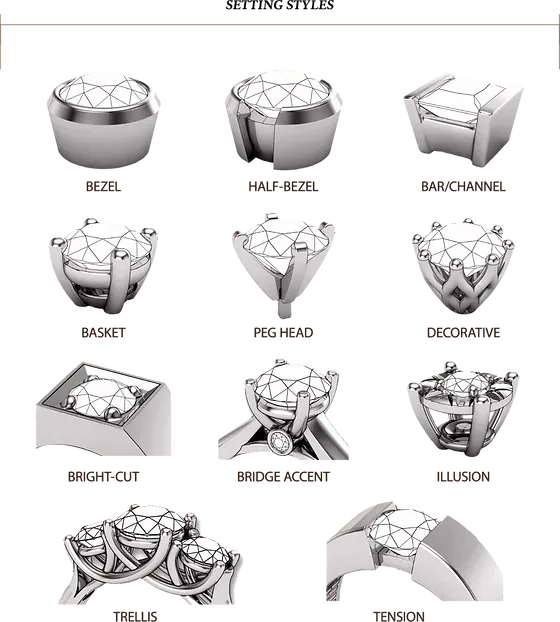

Setting Styles
The first row shows two types of
Bezel
and
Bar
settings. A Bezel means that metal goes all the way around the stone. This is the most secure type of stone setting as it ensures you have a lip of metal around the whole stone. The partial or
Half Bezel
cuts about half of the metal from opposing sides to better show off the stone. This is a great idea to help let more light into the stone. The last is a
Bar
setting, this is typically a straight line of metal that holds in a stone, similarly to a bezel. Where there are multiple of these settings in a row, it is called a
Channel Setting.
The second row shows the classic, Basket setting. There are 4 (sometimes 6 or 8) prongs supported by a ring or two of metal for added support. The second is a Peg Head. These settings tend to stick up higher off the rest of the piece and sits right on top of a shank for what we call a "Cathedral" mounting. The third is a decorative mounting. This type of prong setting can have any number of prongs, but is paired with a design, rather than the basket or the peg.
The third row are alternative prong-like settings. The first is a Bright Cut. the edges of the surrounding metal are given a high polish to make the stone appear larger. The stone is also set lower to better protect the stone. The center setting is a diamond accented setting, similar to the basket setting. The bezel set accent stone adds support to the setting, as well as adding a bit more bling to the profile of the ring. The far right setting is an Illusion Setting. Similarly to the bright cut setting, this setting is made to make smaller stones look larger than they are.
On the last row, you will see another example of a channel set ring. In this case, it can also be called a Tension Setting.
Many tension set rings don't have any metal under the center stone and are held in by the two opposing sides of the shank, giving the illusion of the stone floating in the band.
A Trellis ring is composed of swooping and overlapping wires that make up the "Trellis". This designs is most often used in three-stone settings.